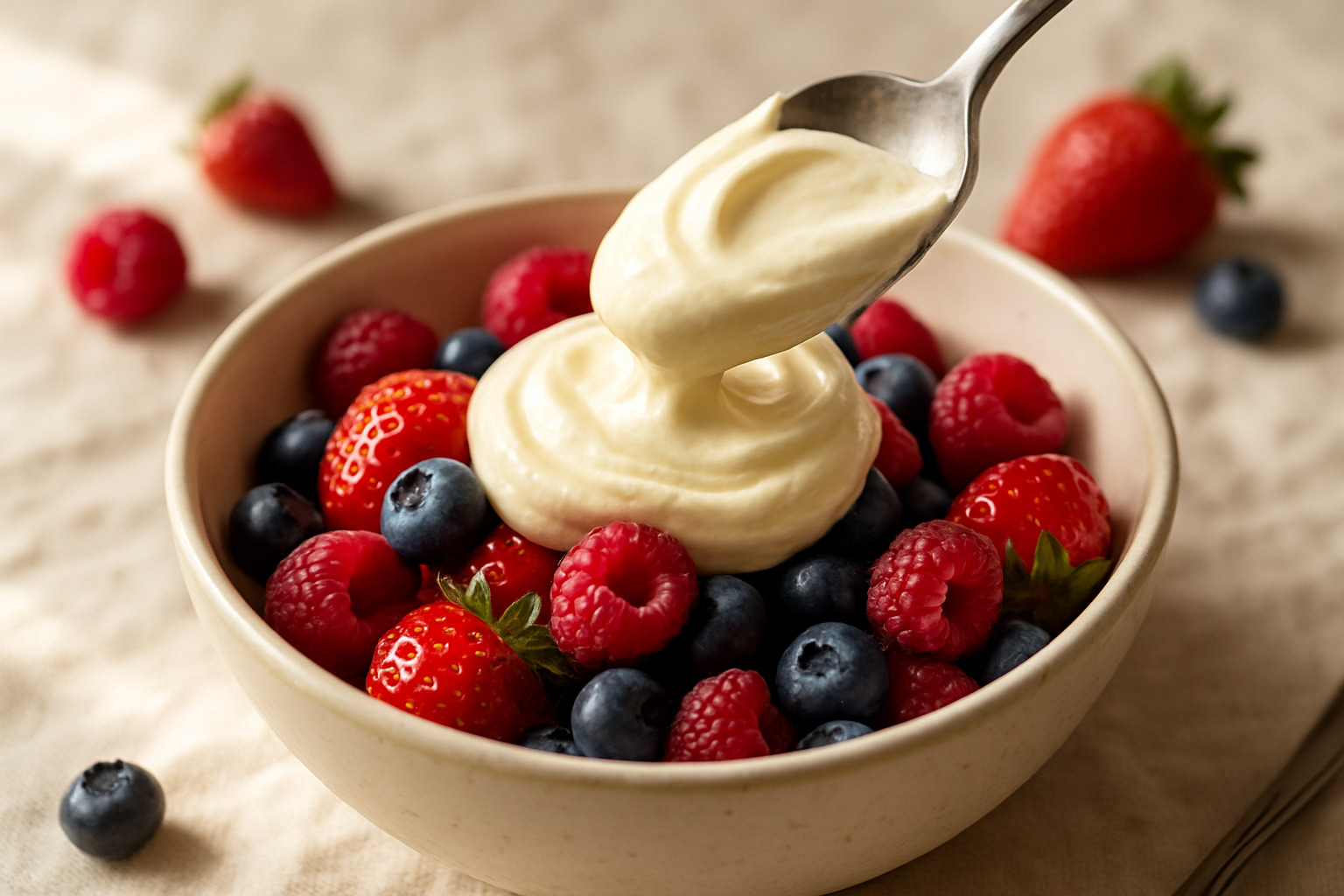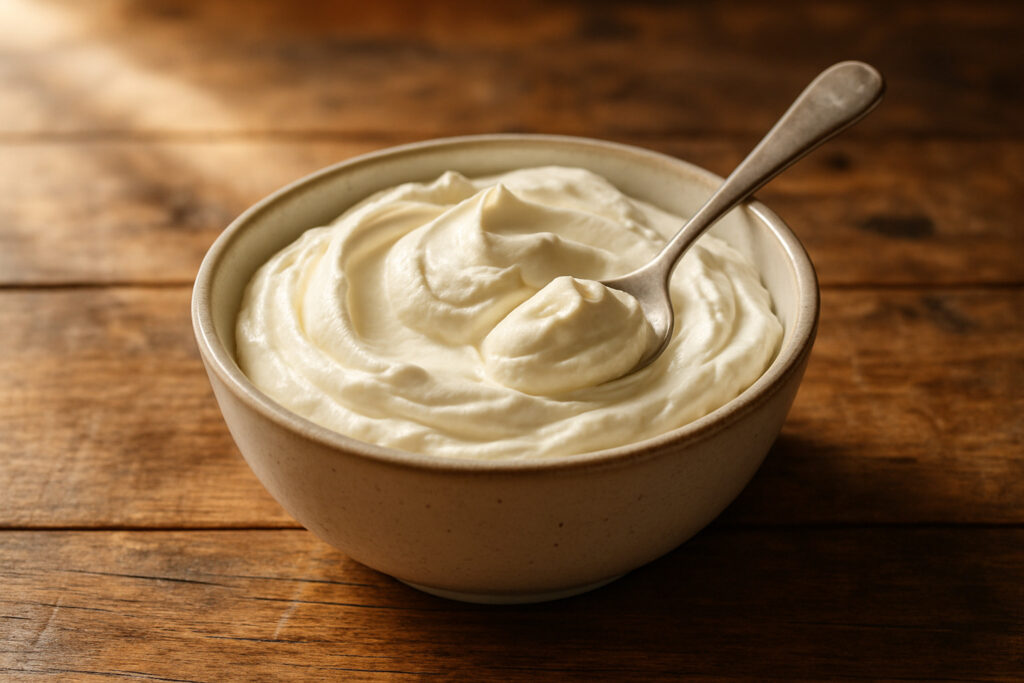What Makes Mascarpone the Creamiest Cheese in Your Kitchen
Mascarpone is a luxurious Italian cream cheese with 70-75% butterfat content that transforms ordinary dishes into restaurant-quality creations. This silky, ivory-colored cheese from Italy’s Lombardy region has been captivating food lovers since the 16th century.
Quick Mascarpone Facts:
- Origin: Lombardy, Italy (16th-17th century)
- Fat Content: 70-75% (vs. cream cheese at 33%)
- Flavor: Delicately sweet, buttery, slightly acidic
- Texture: Smooth, spreadable, melt-in-your-mouth
- Pronunciation: mas-car-POH-nay (not “mars-capone”)
- Main Uses: Tiramisu, risotto, dessert frostings, savory sauces
Unlike regular cream cheese, mascarpone is made by heating heavy cream and adding acid (like lemon juice) to create curds. The result? A cheese so rich and creamy it’s often called “Italian butter.”
Whether you’re a traveling foodie seeking authentic Italian flavors or a home cook wanting to lift your dishes, mascarpone offers endless culinary possibilities. From the classic tiramisu that made it famous to savory pasta sauces that rival New York City’s finest Italian restaurants, this versatile cheese bridges the gap between simple ingredients and extraordinary experiences.
The best part? You can make it at home with just two ingredients, or find quality versions at most grocery stores to experiment with immediately.
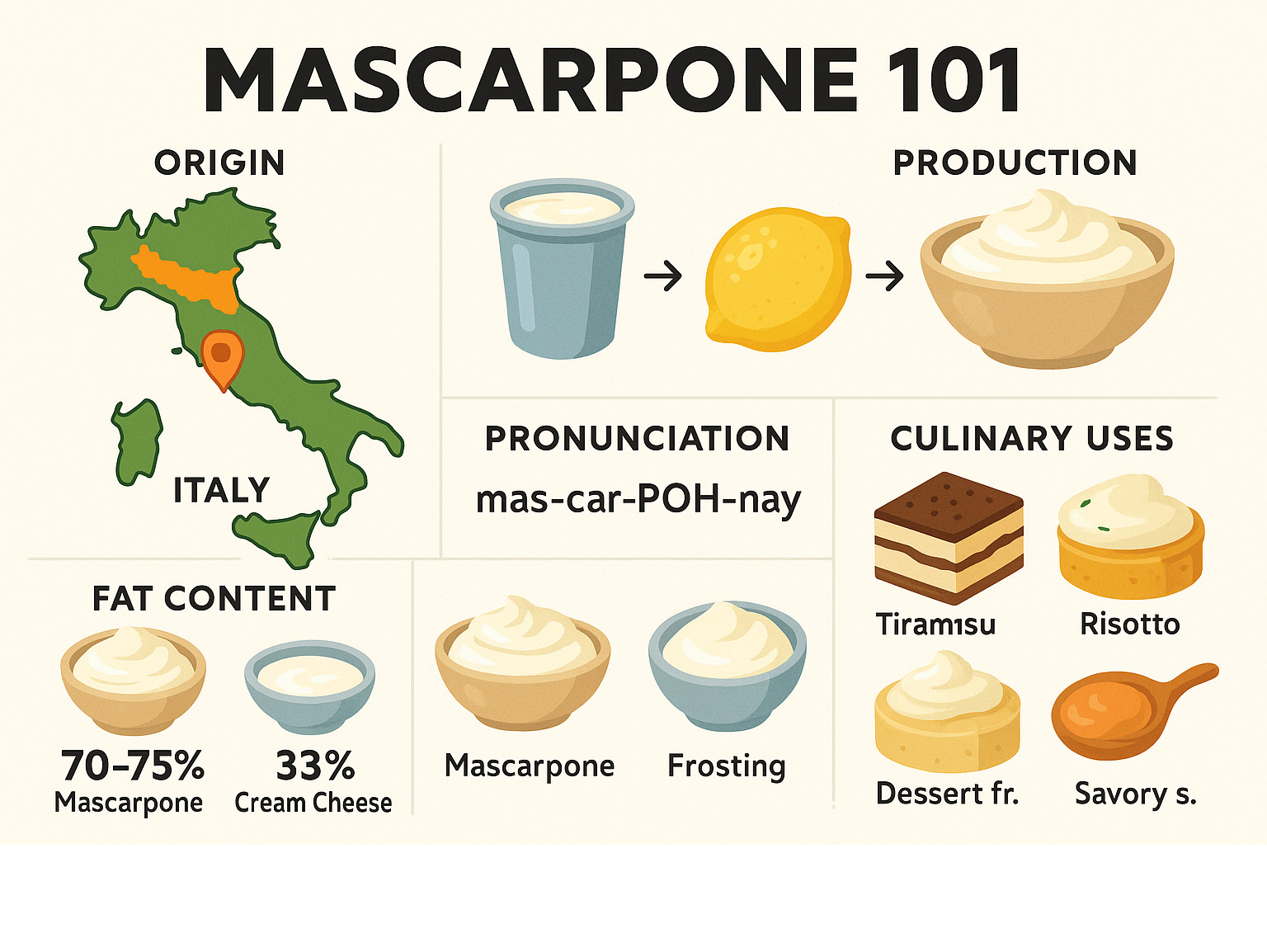
Mascarpone Origins & Pronunciation
Picture the rolling hills of Italy’s Lombardy region in the 1500s, where cattle grazed peacefully in the fertile Po Valley. It was here that Italian cheesemakers stumbled upon something extraordinary while working with their incredibly rich local cream. What started as a happy accident became mascarpone – one of Italy’s most beloved culinary treasures.
This wasn’t just any cheese findy. The Italian government now protects mascarpone with the prestigious P.A.T. (Prodotto Agroalimentare Tradizionale) designation, which legally safeguards its Lombardy origins and traditional production methods. Think of it as Italy’s way of saying “this is the real deal.”
The name itself tells a delicious story, though food historians can’t quite agree on which version is true. The most charming tale involves a Spanish governor who tasted the cheese and exclaimed “mas que bueno” – meaning “more than good!” The more scholarly explanation traces it back to “mascarpia,” the local Lombardy dialect word for ricotta, or possibly “mascarpa,” referring to a whey byproduct used in traditional cheesemaking.
Now, let’s tackle the pronunciation that trips up even seasoned food lovers: mas-car-POH-nay. Please, not “mars-capone” like the famous gangster – that makes Italian chefs everywhere shed a tiny tear. Getting this right shows you truly appreciate the cheese’s rich heritage.
The Birth of Mascarpone
The Po Valley wasn’t just any farming region – it was a dairy paradise. The lush pastures produced milk so rich and creamy that local cheesemakers had plenty to experiment with. These innovative artisans finded that adding tartaric acid (a natural byproduct found coating wine barrels) to heated cream created something magical.
This findy wasn’t pure luck – it was born from the perfect storm of local resources and necessity. Lombardy’s thriving wine industry meant tartaric acid was readily available, while the region’s strong dairy tradition demanded creative ways to preserve and transform their abundant cream.
The result was so remarkable that Pantaleone da Confienza mentioned it in his 1477 work “Summa lacticiniorum” – one of the first written records of this heavenly cheese. From those humble beginnings in Italian farmhouses, mascarpone eventually traveled the world, bringing a taste of Lombardy’s countryside to kitchens everywhere.
How Mascarpone Is Made (and How to DIY)
The beauty of mascarpone lies in its neat simplicity – this luxurious Italian cheese is essentially heavy cream transformed through gentle heat and acid. Commercial producers have perfected this ancient technique, heating cream to exactly 185°F (85°C) before adding citric or tartaric acid to create those perfect, silky curds.
The magic happens when science meets tradition. As the cream reaches that crucial 185-190°F temperature, a splash of acid triggers the change. The mixture thickens beautifully, developing that signature velvety texture that makes mascarpone so irresistible. After just three minutes of gentle cooking, the cream should coat a wooden spoon like silk.
What follows is pure patience. The warm mixture cools gradually, then gets strained through fine cheesecloth for a full 24 hours in the refrigerator. This slow draining process separates the precious mascarpone from the whey, leaving behind that ivory-colored treasure.
Your home kitchen needs surprisingly little equipment for this culinary magic: an instant-read thermometer (absolutely essential for temperature control), a heavy-bottomed saucepan, quality cheesecloth or a fine kitchen towel, a reliable fine-mesh strainer, and a glass bowl to catch the whey.
Here’s what makes the effort worthwhile – from just 2 cups of heavy cream, you’ll yield about 1.5 to 2 cups of finished mascarpone. That’s an impressive return that transforms a simple ingredient into something extraordinary. More info about Heavy Cream can guide you toward choosing the perfect base for your homemade creation.
Homemade Mascarpone Step-by-Step
Creating restaurant-quality mascarpone at home requires just two ingredients: 2 cups of heavy cream (with 35-40% fat content) and 3 tablespoons of fresh lemon juice. That’s it – no complicated techniques or mysterious additives.
Start by heating your cream in a heavy saucepan over medium heat, stirring occasionally until it reaches that crucial 185°F. Add the lemon juice and stir constantly for exactly 3 minutes, maintaining that temperature like your culinary reputation depends on it (because it does). You’ll know you’ve succeeded when the mixture thickens enough to coat your spoon.
The cooling phase requires patience. Let the mixture reach room temperature – about 30 minutes – then give it a gentle whisk. Line your fine strainer with cheesecloth over a bowl, pour in your mixture, and cover with plastic wrap. The refrigerator does the rest of the work over the next 8-24 hours, depending on how thick you want your final product.
Ultra-pasteurized cream works perfectly fine, despite what some purists might tell you. As long as it contains at least 30% fat, you’ll get excellent results. Regular pasteurized cream might give you slightly better texture, but the difference is minimal.
The cost savings are remarkable – homemade mascarpone costs roughly one-third the price of store-bought versions. When you’re planning dinner parties or special occasions requiring larger quantities, this difference becomes significant.
Mascarpone Troubleshooting
Even experienced cooks sometimes encounter separation issues with their mascarpone. If your mixture looks grainy or separated, the temperature likely got too high during the cooking process. Prevention means using lower heat and stirring more gently. You can sometimes rescue separated mascarpone by whisking in a tablespoon of cold cream.
Graininess usually signals that the acid was added too quickly or the temperature spiked unexpectedly. Try straining the mixture through finer cloth or giving it a very gentle blend with an immersion blender. The key word here is gentle – aggressive mixing will only make things worse.
Watery curds indicate either insufficient acid or inadequate draining time. Add another tablespoon of lemon juice and extend the straining period to 24-48 hours. Sometimes patience is the best ingredient.
Temperature control makes the difference between silky success and grainy disappointment. That instant-read thermometer isn’t optional – it’s your best friend. Maintain steady, gentle heat throughout the process. Just 10-15 degrees too high can ruin an entire batch, turning your culinary trip into an expensive learning experience.
Nutritional Profile & Comparisons
When you’re spooning that luxurious mascarpone into your tiramisu or stirring it into risotto, you’re working with one of the richest cheeses in the dairy case. With 70-75% butterfat content, this Italian beauty packs about 120 calories per ounce – roughly the same as a small handful of nuts, but with infinitely more culinary magic.
Here’s what makes mascarpone nutritionally unique: it contains 429 calories per 100g, with an impressive 43g of fat that gives it that signature silky texture we all crave. You’ll also get 3.6g of protein, 143mg of calcium for your bones, and yes, it’s naturally gluten-free and perfect for vegetarians. For detailed nutritional data, the USDA FoodData Central provides comprehensive information about dairy nutrition.
The high fat content isn’t just about indulgence – those quality fats are what make mascarpone melt so beautifully into warm sauces and create that cloud-like texture in desserts. Think of it as concentrated cream that’s been transformed into something even more wonderful.
One thing to keep in mind: mascarpone contains over 3000mg of lactose per 100g, so if dairy doesn’t agree with you, you’ll want to enjoy it in small amounts or consider taking a lactase enzyme beforehand. The good news? It’s completely safe during pregnancy when made from pasteurized milk, which most commercial versions are.
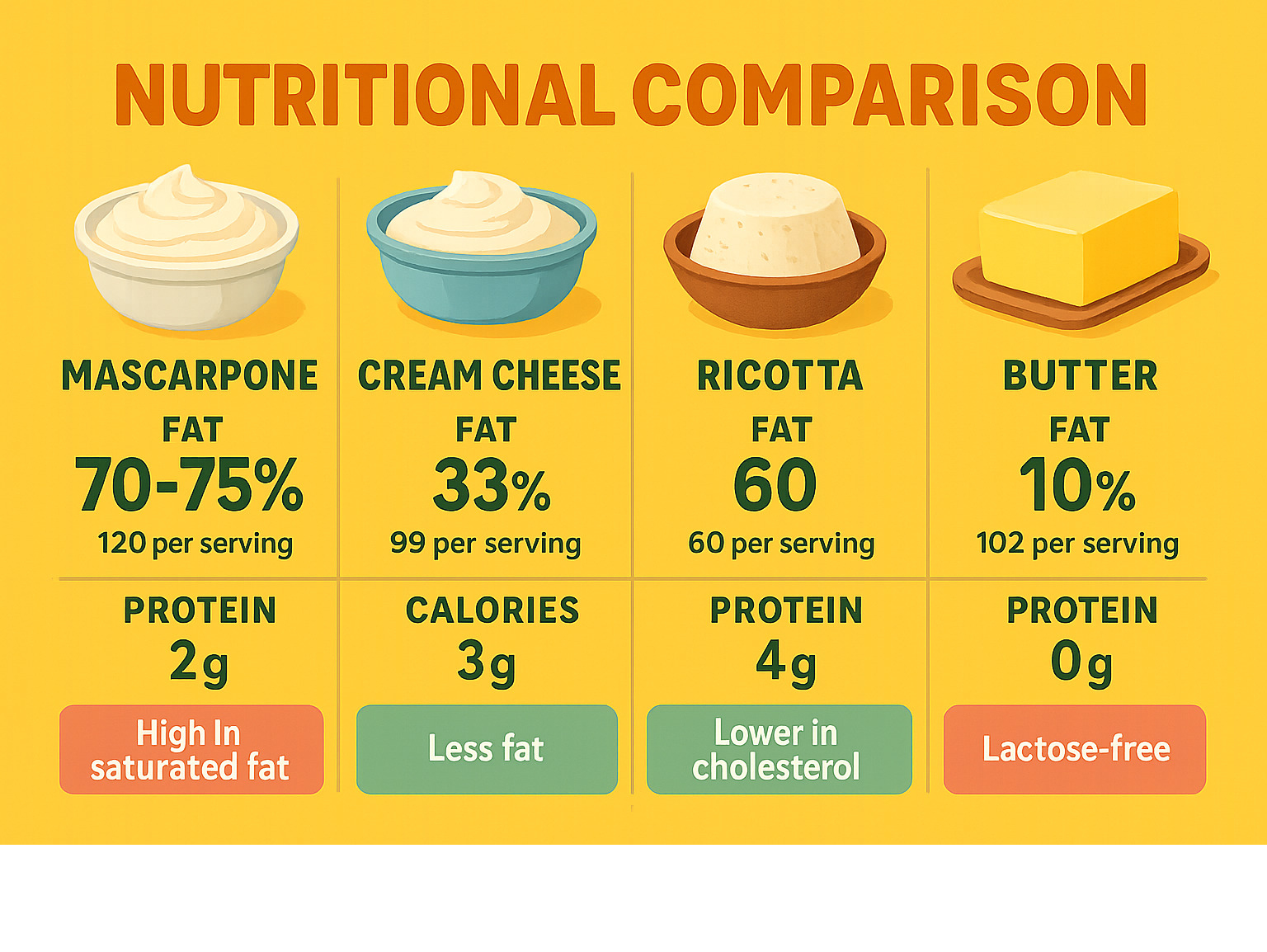
Mascarpone vs Cream Cheese
The mascarpone versus cream cheese showdown comes down to fat content and flavor philosophy. While cream cheese sits at a respectable 33% milk fat, mascarpone struts in with its 70-75% butterfat like the Italian cousin who studied abroad and came back impossibly sophisticated.
Mascarpone is made from cream and acid – that’s it. Cream cheese involves milk, acid, and stabilizers, creating a firmer texture that holds its shape better. This means mascarpone melts into silky sauces like a dream, while cream cheese prefers to maintain its composure in frostings and spreads.
Flavor-wise, mascarpone whispers sweet, buttery notes while cream cheese speaks up with tangy authority. In desserts, mascarpone creates that melt-in-your-mouth luxury you experience in authentic Italian restaurants, while cream cheese delivers the familiar tang we love in New York-style cheesecake.
For cooking swaps, they work interchangeably in most recipes, though expect richer, more delicate results with mascarpone. Just remember that mascarpone’s higher fat content means it’s less stable for decorated cakes that need to hold their shape for hours.
Dietary Considerations
Pregnancy safety is straightforward with mascarpone – it’s perfectly safe when made from pasteurized milk, which covers virtually all commercial brands. Always check labels if you’re buying artisanal versions, and practice good kitchen hygiene when making it at home.
Lactose intolerance presents more of a challenge since mascarpone contains significant lactose. However, tolerance varies wildly between individuals. Some people handle small amounts just fine, especially when mascarpone is mixed into other dishes rather than eaten straight. Lactase enzyme supplements can be your friend if you’re determined to enjoy that perfect tiramisu.
Portion moderation becomes your secret weapon with such a calorie-dense ingredient. Think of mascarpone as a flavor improver rather than a main event – a few spoonfuls can transform an ordinary dish into something restaurant-worthy without derailing your eating goals. A little truly goes a long way in creating those rich, satisfying flavors that make dining experiences memorable.
Cooking & Baking with Mascarpone
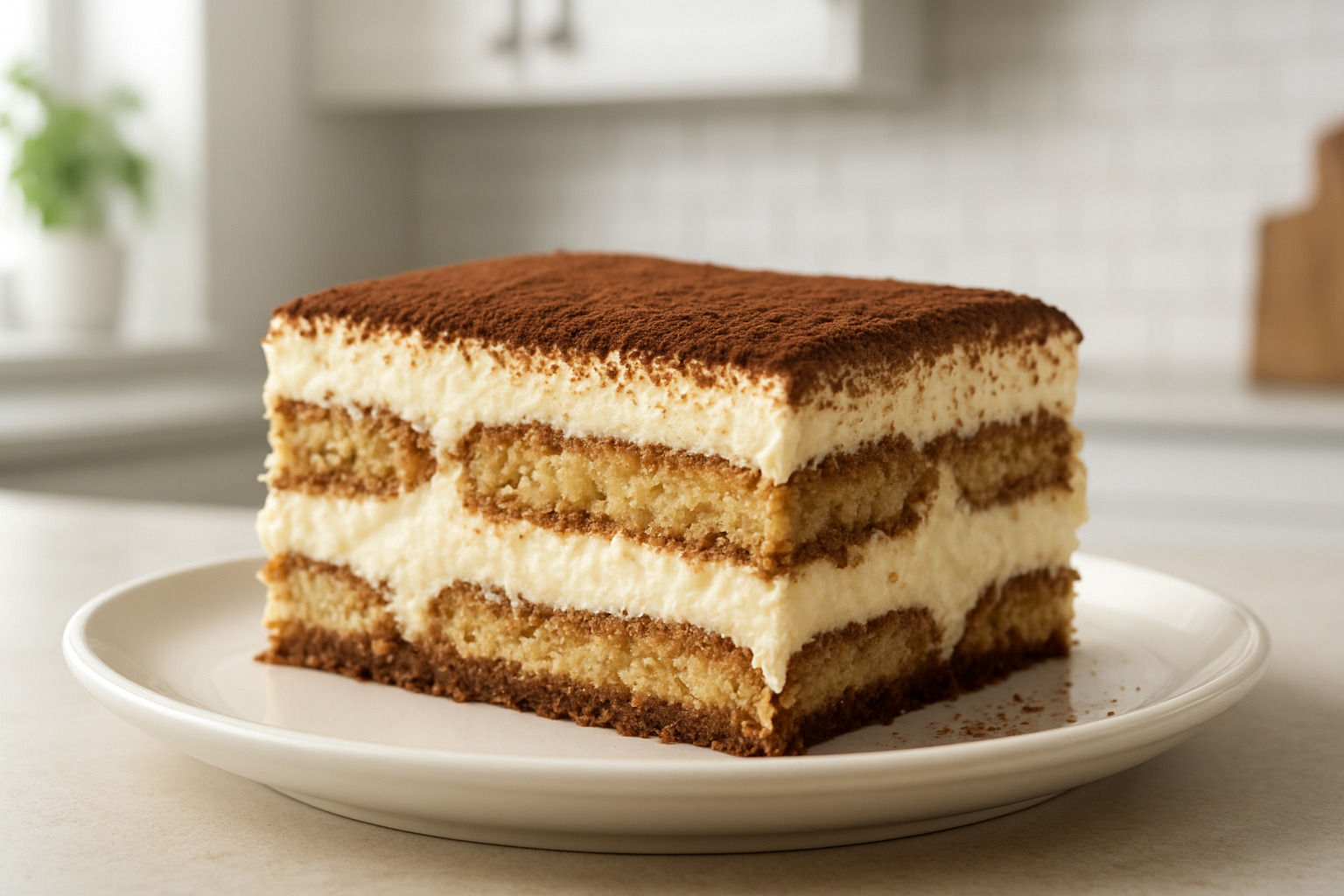
There’s something magical about mascarpone that transforms ordinary dishes into restaurant-quality masterpieces. This Italian cream cheese doesn’t just add richness – it creates an entirely different eating experience that makes people stop mid-bite and wonder what makes everything taste so incredible.
In the sweet world, mascarpone is the secret behind those frostings that taste like clouds and cheesecakes that seem to melt on your tongue. It’s what makes authentic tiramisu so unforgettable and turns simple Bundt cakes into special occasion desserts. The cheese’s delicate sweetness and silky texture work beautifully with coffee flavors, chocolate, and fresh berries.
But here’s where mascarpone really surprises people – it’s equally brilliant in savory cooking. Stir a spoonful into your risotto at the very end, and watch it transform into something you’d pay premium prices for in New York City’s finest Italian restaurants. Add it to pasta sauces, and suddenly you have that restaurant-quality silkiness that coats every noodle perfectly.
The beauty of cooking with mascarpone lies in its versatility. Unlike heavy cream that can break under heat or cream cheese that fights back when you try to blend it, mascarpone cooperates beautifully when treated with a little respect. It enriches without overwhelming, adds luxury without pretension.
Many home cooks find that mascarpone bridges the gap between everyday cooking and those special dishes that create lasting food memories. Whether you’re exploring French Desserts with an Italian twist or creating comfort food that tastes like it came from a professional kitchen, this cheese delivers results that impress both family and guests.
Iconic Recipes Featuring Mascarpone
Tiramisu remains the dish that introduced most of the world to mascarpone’s magic. The classic version combines coffee-soaked ladyfingers with a luxurious cream made from egg yolks, sugar, and mascarpone. What makes tiramisu so special isn’t just the coffee or the cocoa dusting – it’s how mascarpone creates that perfect balance between richness and lightness that makes each spoonful irresistible.
Cannoli cream gets a serious upgrade when you swap traditional ricotta for mascarpone. Mix it with powdered sugar, vanilla, and mini chocolate chips, and you’ll create a filling that’s silkier and more luxurious than anything you’ll find in most bakeries. The texture difference is remarkable – where ricotta can be slightly grainy, mascarpone creates pure smoothness.
Mushroom risotto reaches perfection when you finish it with mascarpone instead of the usual butter and Parmesan combination. The cheese adds incredible creaminess without competing with the earthy mushroom flavors. It’s one of those simple swaps that makes people think you’ve suddenly become a much better cook.
Mascarpone mashed potatoes sound fancy, but they’re surprisingly simple to make. Replace your usual butter and cream with mascarpone, and you’ll get fluffy, flavorful potatoes that taste like they belong in a high-end steakhouse. The cheese adds richness without the heaviness that sometimes comes with butter-loaded versions.
Pro Tips for Working with Mascarpone
Room-temperature blending is absolutely crucial when working with mascarpone. Cold cheese straight from the fridge will fight you every step of the way, creating lumps that refuse to disappear. Let it sit on your counter for about 30 minutes before using, and it will blend smoothly into any mixture without protest.
Folding techniques make all the difference when incorporating mascarpone into whipped cream or delicate egg mixtures. Think gentle, swooping motions rather than aggressive stirring. You want to preserve all that lovely lightness, not beat it into submission. Aggressive mixing turns silky mascarpone into dense disappointment.
Stabilizing whipped cream becomes important when you’re making mascarpone whipped cream for desserts that need to hold their shape. The cheese creates incredibly delicious whipped cream, but it’s less stable than regular versions. If you need it to look perfect for hours, add a tiny amount of gelatin. For immediate serving, the natural texture is absolutely perfect.
When making sauces with mascarpone, always add it gradually and off the heat. The cheese wants to blend smoothly, but it can curdle if shocked with high temperatures. Stir it in gently, keep the heat low, and never let the mixture boil once the mascarpone joins the party. This simple approach ensures silky, professional-looking results every time.
Storage, Substitutes & Charcuterie Uses
The reality of mascarpone storage might surprise you – this luxurious cheese has a surprisingly short shelf life. Once opened, you’ve got just 3-4 days to use it up, which makes planning your culinary trips essential. The high fat content that creates that amazing creamy texture also makes mascarpone more perishable than regular cream cheese.
Store your opened mascarpone in the refrigerator at a consistent 40°F or below, preferably in its original container or transferred to an airtight one. The cheese easily absorbs other flavors, so that airtight seal protects both the mascarpone and your other refrigerated foods. Watch for warning signs like mold spots, sour odors, or watery separation – when in doubt, trust your senses and toss it out.
Freezing mascarpone is technically possible for up to 3 months, but it’s a bit like freezing silk – you can do it, but it won’t be quite the same afterward. The texture becomes grainy and may separate when thawed, making frozen mascarpone best suited for cooked dishes like sauces or baked goods where the changed texture won’t be noticeable.
When you can’t find mascarpone at your local store, several substitutes can save the day. Clotted cream comes closest to matching the richness and texture, while crème fraîche offers similar tanginess with slightly less indulgence. For a DIY approach, blend 8 ounces of cream cheese with 1/4 cup heavy cream and 1 tablespoon lemon juice – it won’t fool an Italian grandmother, but it’ll work beautifully in most recipes.
On charcuterie boards, mascarpone plays the role of creamy peacemaker between sharp aged cheeses and salty cured meats. Pair it with fresh figs, drizzled honey, and crusty artisan bread for a combination that feels both rustic and refined. The mild, buttery flavor won’t compete with stronger elements but adds that luxurious touch that makes guests feel special. More info about Charcuterie Board Ideas can help you create stunning spreads that showcase mascarpone’s versatility.
Mascarpone Troubleshooting & FAQs
Lumpy mascarpone usually means temperature shock or overzealous mixing has disrupted the delicate texture. The fix is gentle – let it come to room temperature naturally, then fold in a tablespoon of warm cream with the patience of a zen master. Aggressive stirring will only make things worse.
Watery separation happens when mascarpone gets too warm or sits too long in inconsistent temperatures. You can drain off the excess liquid and use the remaining solids in cooking applications where perfect texture matters less, like pasta sauces or risottos.
Reheating mascarpone requires a light touch – never apply direct heat or high temperatures. Instead, add it to warm dishes off the heat, stirring gently until it melts into silky perfection. Think of it as the difference between a gentle hug and a firm handshake – mascarpone definitely prefers the hug approach.
Frequently Asked Questions about Mascarpone
What does mascarpone taste like?
Mascarpone delivers a uniquely luxurious flavor that’s both familiar and sophisticated. Imagine the richest heavy cream you’ve ever tasted, then add a gentle sweetness and the faintest whisper of tang – that’s mascarpone in a nutshell.
The flavor is delicately buttery without being overwhelming, with a subtle acidic finish that’s much gentler than cream cheese. It’s like what butter dreams of becoming – rich and indulgent but never heavy or cloying on your palate.
What makes mascarpone so special is its restraint. The flavor doesn’t compete with other ingredients, which is why it works so beautifully in both tiramisu and savory pasta sauces. Many food lovers describe the experience as “luxurious cream that melts on your tongue,” and honestly, that’s pretty accurate.
The high fat content creates an almost silky mouthfeel that coats your palate without leaving any greasy residue. It’s sophisticated comfort food at its finest.
Can mascarpone be frozen successfully?
Here’s the honest truth about freezing mascarpone: you can do it, but you probably shouldn’t if texture matters to you. While mascarpone will keep for up to 3 months in the freezer, the freezing process causes the water and fat to separate, leaving you with a grainy, less smooth texture when thawed.
Think of it this way – if you’re planning to make tiramisu or whipped frosting, frozen and thawed mascarpone just won’t give you those silky results you’re after. The texture changes are simply too noticeable in applications where smoothness is everything.
However, thawed mascarpone works perfectly fine in cooked dishes where texture is less critical. Pasta sauces, baked goods, and soups can handle the slightly grainier texture without any issues. Just make sure to thaw slowly in the refrigerator and give it a gentle stir before using.
For the best culinary experience, buy only what you need and use fresh mascarpone within 3-4 days of opening. Your taste buds will thank you for the extra effort.
Is mascarpone gluten-free and vegetarian?
Great news for those with dietary restrictions – mascarpone is naturally both gluten-free and vegetarian-friendly. Traditional mascarpone contains only heavy cream and acid (usually lemon juice, citric acid, or tartaric acid), with no gluten-containing ingredients or animal rennet in sight.
This makes mascarpone perfect for vegetarians following a lacto-vegetarian diet, and safe for those avoiding gluten due to celiac disease or sensitivity. However, always check commercial labels for any additives, especially in flavored versions that might sneak in unexpected ingredients.
Cross-contamination is possible in facilities that also process wheat, so if you have severe gluten sensitivity, look for products with certified gluten-free labels. Most major brands are transparent about their production processes.
The one group that can’t enjoy mascarpone? Vegans, since it’s made from dairy. But for everyone else managing gluten-free or vegetarian diets, this creamy Italian cheese opens up a world of delicious possibilities without compromise.
Conclusion
Mascarpone represents the perfect intersection of simplicity and sophistication – a cheese that transforms ordinary ingredients into extraordinary culinary experiences. From its humble beginnings in Lombardy’s Po Valley to its starring role in kitchens worldwide, this creamy cheese continues to bridge traditional Italian craftsmanship with modern culinary innovation.
Whether you’re recreating the authentic tiramisu that made mascarpone famous, enriching a simple risotto to restaurant quality, or experimenting with homemade versions in your own kitchen, this versatile Italian cheese offers endless possibilities for culinary creativity. Its adaptability spans from delicate dessert frostings to robust savory sauces, making it an invaluable addition to any food lover’s repertoire.
The beauty of mascarpone lies in its accessibility. With just heavy cream and lemon juice, you can create this luxurious cheese at home for a fraction of the store-bought cost. Yet when you choose quality commercial versions, you’re participating in a centuries-old tradition of Italian craftsmanship that has been perfected over generations.
At The Dining Destination, we believe that understanding ingredients like mascarpone deepens our appreciation for the culinary traditions that connect us across cultures. When you incorporate this creamy Italian treasure into your cooking, you’re not just adding richness to your dishes – you’re creating new memories around your own table while honoring time-tested techniques.
The next time you’re planning a special meal or seeking to lift everyday dishes, mascarpone offers a simple path to extraordinary results. Its rich history, versatile applications, and accessible production make it perfect for both novice cooks and experienced chefs looking to add authentic Italian flair to their culinary trips.
For more inspiration on creating memorable food experiences, explore our guide on How to Curate the Perfect Foodie Gift Box, where mascarpone-based treats make excellent additions to any gourmet collection.
